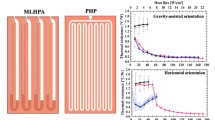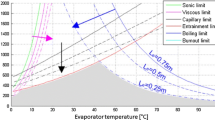Abstract
This work proposes a novel flat heat pipe technology, namely the rod-plate heat pipe, formed by the diffusion bonding of a set of parallel rods, of around 8 mm diameter, between flat plates of approximately 500 × 60 × 2 mm3. This design is inspired by the mini wire-plate heat pipe concept. This work is the first in the literature to apply this technology to large size heat pipes. A theoretical model is devised and used to predict the fluid distribution along the heat pipe, detect regions of flooding and dry-out and determine the best charging volume. Experiments are performed with a stainless-steel device operating in horizontal orientation with water as working fluid. Electrical cartridge resistances play the role of the evaporator heat source, while the condenser is cooled by either natural convection and radiation or heat exchangers linked to a thermal bath. For the experiments using a device with an exposed condenser, the minimum thermal resistance is 0.147 °C/W, for 88.50 W for heat input. The operation temperature increases with heat input up to 326.56 °C for a heat load of 191.40 W. The thermal resistances of the heat pipe cooled by heat exchangers have a minimum of 0.123 °C/W at 171.57 W heat transport rate, for a 40 °C thermal bath temperature. The theoretical results and data obtained so far corroborate the feasibility of this technology, with devices able to transfer up to 22.18 W per groove.












































Similar content being viewed by others
Abbreviations
- A:
-
Cross-section area, m2
- cp :
-
Specific heat capacity, J kg-1 K-1
- Dh :
-
Hydraulic diameter, m
- Dφ :
-
Deviation
- f:
-
Friction factor
- FR:
-
Filling ratio
- g:
-
Gravity, kg m s-2
- H:
-
Meniscus height, m
- h:
-
Step size, m
- hlv :
-
Latent heat, J kg-1
- \(\overline{h_{si}}\) :
-
Convection heat transfer coefficient, W °C-1 m-2
- I:
-
Current, A
- L:
-
Length, m
- l:
-
Axial position, m
- \(\dot{m}\) :
-
Mass flow rate, kg s-1
- N:
-
Number of nodes
- \(\overline{{Nu }_{L}}\) :
-
Nusselt number
- P:
-
Pressure, Pa
- Pr:
-
Prandtl number
- pl :
-
Liquid cross-section perimeter, m
- ps :
-
Surface perimeter, m
- pv :
-
Vapor wetted perimeter, m
- pwl :
-
Liquid wetted perimeter, m
- Q:
-
Heat transfer rate, W
- q'':
-
Heat flux, W m-2
- R:
-
Rod radius, m
- RaL :
-
Rayleigh number
- \({Re}_{h}\) :
-
Reynolds number
- Rt :
-
Thermal resistance, K W-1
- rm :
-
Radius-of-meniscus, m
- T:
-
Temperature, °C
- u:
-
Velocity, m s-1
- vc :
-
Charging volume, m3
- U:
-
Standard uncertainty
- V:
-
Voltage, V
- W:
-
Meniscus width, m
- w:
-
Rod pitch (center-to-center distance), m
- x:
-
Axial position, m
- α:
-
Contact angle, rad
- α:
-
Thermal diffusivity, m2 s-1
- β:
-
Thermal expansion coefficient, K-1
- β1 :
-
Half- angle of the rod-liquid opening, rad
- β2 :
-
Half-angle of the meniscus curvature, rad
- ε:
-
Emissivity
- ξ:
-
Shape factor
- λ:
-
Thermal conductivity, W m-1 °C-1
- ν:
-
Momentum diffusivity, m2 s-1
- ρ:
-
Density, kg m-3
- ρc :
-
Charged density, kg m-3
- σ:
-
Boltzmann constant, W m-2 K-4
- σl :
-
Liquid surface tension, N m-1
- τ:
-
Shear stress, N m-2
- φ:
-
Generic variable
- ψ:
-
Angle of inclination, rad
- ψs :
-
Irregularity shape factor
- ϕ:
-
Channel aspect ratio
- A:
-
System A
- a:
-
Adiabatic section
- B:
-
System B
- b:
-
Bibliography
- c:
-
Condenser
- e:
-
Evaporator
- f:
-
Buoyant fluid
- l:
-
Liquid
- loss:
-
Loss
- max:
-
Maximum
- nc:
-
Natural convection
- op:
-
Operation
- p:
-
Present
- rad:
-
Radiation
- s:
-
Surface
- tb:
-
Thermal bath
- v:
-
Vapor
- w:
-
Water
- ∞:
-
Environment
References
Cotter TP (1984) Principles and prospects for micro heat pipes. In 5th International Heat Pipe Conference, Tsukuba, Japan. pp 328–335
Vasiliev LL (2008) Micro and miniature heat pipes - electronic component coolers. Appl Therm Eng 28(4):266–273. https://doi.org/10.1016/j.applthermaleng.2006.02.023
Vieira de Paiva K, Barbosa Henriques Mantelli M, Kessler Slongo L (2011) Thermal behavior analysis of wire mini heat pipe. J Heat Transfer 133(12):1–9. https://doi.org/10.1115/1.4004526
Panahi M, Heydari HR, Karimi G (2021) Effects of micro heat pipe arrays on thermal management performance enhancement of cylindrical lithium-ion battery cells. Int J Energy Res 1–13. https://doi.org/10.1002/er.6604
Qu J, Wu H, Cheng P, Wang Q, Sun Q (2017) Recent advances in MEMS-based micro heat pipes. Int J Heat Mass Transf 110:294–313. https://doi.org/10.1016/j.ijheatmasstransfer.2017.03.034
Wang YX, Peterson GP (2002) Analysis of wire-bonded micro heat pipe arrays. J Thermophys Heat Transf 16(3)
Rag RL, Sobhan CB, Peterson GP (2018) Computational analysis of wire-bonded micro heat pipe: Influence of thermophysical parameters. J Thermophys Heat Transf 32(4):925–932. https://doi.org/10.2514/1.T5359
Launay S, Sartre V, Mantelli MBH, De Paiva KV, Lallemand M (2004) Investigation of a wire plate micro heat pipe array. Int J Therm Sci 43(5):499–507. https://doi.org/10.1016/j.ijthermalsci.2003.10.006
Paiva KV, Mantelli MBH (2015) Theoretical thermal study of wire-plate mini heat pipes. Int J Heat Mass Transf 83:146–163. https://doi.org/10.1016/j.ijheatmasstransfer.2014.11.049
Batista JVC (2021) Development of a hybrid mini heat pipe for electronics cooling applications. Universidade Federal de Santa Catarina
Rag RL, Sobhan CB (2009) Computational analysis of fluid flow and heat transfer in wire-sandwiched microheat pipes. J Thermophys Heat Transf. https://doi.org/10.2514/1.44101
Mantelli MBH (2021) Thermosyphons and heat pipes: theory and applications. Springer
Sandemeyer Steel Company (2013) Specification sheet: alloy 316 / 316L (UNS S31600, S31603). https://www.sandmeyersteel.com/images/316-316l-317l-spec-sheet.pdf
Mortean MVV (2017) Trocador de Calor Compactos Soldados por Difusão: Fabricação e Modelagem (Doctoral Thesis). Federal University of Santa Catarina, Florianópolis, Santa Catarina, Brazil
Klein S, Alvarado F (2002) Engineering equation solver. F-Chart Software. p 2. https://www.fchartsoftware.com/ees/
Carey VP (2020) Liquid-vapor phase-change phenomena: an introduction to the thermophysics of vaporization and condensation processes in heat transfer equipment, 3rd edn. CRC Press. Taylor & Francis Group, Boca Raton, Florida, United States. ISBN-13: 978-1-4987-1661-1
Longtin JP, Badran B, Gerner FM (1994) A one-dimensional model of a micro heat pipe during steady- state operation. J Heat Transfer 116(3):709–715. https://doi.org/10.1115/1.2910926
Ma HB, Peterson GP, Lu XJ (1994) The influence of vapor-liquid interactions on the liquid pressure drop in triangular microgrooves. Int J Heat Mass Transf 37(15):2211–2219. https://doi.org/10.1016/0017-9310(94)90364-6
Shah RK, Bhatti MS (1987) Laminar convective heat transfer in ducts, in handbook of single-phase convective heat transfer. Wiley, New York, p 3.45–3.70
Adrian B (2013) Convection Heat Transfer. Wiley, New York
Song JW, Zeng DL, Fan LW (2020) Temperature dependence of contact angles of water on a stainless steel surface at elevated temperatures and pressures: In situ characterization and thermodynamic analysis. J Colloid Interface Sci 561:870–880. https://doi.org/10.1016/j.jcis.2019.11.070
Armstrong JS, Collopy F (1992) Error measures for generalizing about forecasting methods: Empirical comparisons. Int J Forecast 8(1):69–80. https://doi.org/10.1016/0169-2070(92)90008-W
Ziegelheim J, Hiraki S, Ohsawa H (2007) Diffusion bondability of similar/dissimilar light metal sheets. J Mater Process Technol 186(1–3):87–93. https://doi.org/10.1016/j.jmatprotec.2006.12.020
Bucklow IA (1983) Diffusion bonding for product improvement and cost reduction (Seminar Handbook). The Welding Institute, London
Martinelli AE (1996) Diffusion bonding of silicon carbide and silicon nitride to molybdenum. McGill University
American Welding Society (A.W.S) (1978) Welding Handbook: Welding Processes, Arc and Gas Welding and Cutting, Brazing and Soldering, Vol 2, 7th edn. ISBN-10 087171486
Gatti GM (2020) Análise Termo-Hidráulica e Efeitos do Escalonamento em Trocadores de Calor Compactos Unidos por Difusão (Dissertação de Mestrado). Universidade Federal de Santa Catarina, Florianópolis, Santa Catarina, Brazil
Mortean MVV, Buschinelli AJDA, Paiva KVD, Mantelli MBH, Remmel J (2016) Soldagem por difusão de aços inoxidáveis para fabricação de trocadores de calor compactos. Soldag Insp 21(1):103–114. https://doi.org/10.1590/0104-9224/SI2101.10
Li Y, Li Q, Wang Y, Chen J, Cai WH (2022) Optimization of a Zigzag-channel printed circuit heat exchanger for supercritical methane flow. Cryogenics (Guildf) 121(December):2021. https://doi.org/10.1016/j.cryogenics.2021.103415
Shah RK, Sekulic DP (2003) Fundamentals of Heat Exchanger Design. John Wiley & Sons, New York
Incropera FP, Dewitt DP (2011) Fundamentals of heat and mass transfer, 7th edn. John Wiley & Sons, Jefferson City
Goldstein RJ, Sparrow EM, Jones DC (1973) Natural convection mass transfer adjacent to horizontal plates. Int J Heat Mass Transf 16(5):1025–1035. https://doi.org/10.1016/0017-9310(73)90041-0
Lloyd JR, Moran WR (1974) Natural convection adjacent to horizontal surface of various planforms ASME. J Heat Transf 96(4):443–447
Radziemska E, Lewandowski WM (2001) Heat transfer by natural convection from an isothermal downward-facing round plate in unlimited space. Appl Energy 68(4):347–366. https://doi.org/10.1016/S0306-2619(00)00061-1
Churchill SW, Chu HHS (1975) Correlating equations for laminar and turbulent free convection from a vertical plate. Int J Heat Mass Transf 18(11):1323–1329. https://doi.org/10.1016/0017-9310(75)90243-4
Cisterna LHR (2019) Técnicas de Fabricação, Modelagem e Testes de Termossifões Bifásicos de Sódio - Efeitos de Geyser Boiling e de Ponta Fria. FederaL University of Santa Catarina
Joint Committee For Guides In Measurement (2008) Evaluation of measurement data — Guide to the expression of uncertainty in measurement, 1st edn. JCGM 100:2008
Ronald H (1997) Dieck, Measurement uncertainty: methods and applications, 2nd edn. Instrument Society of America, Durham, North Carolina
Omega Engineering Inc. (2023) Thermocouple types. https://www.omega.com/en-us/resources/thermocouple-types. Accessed 6 Aug 2023
Camahan B, L HA, Wilkes JO (1969) Applied numerical methods. Krieger Publishing Company, Malabar, Florida
Faghri A (2012) Review and advances in heat pipe science and technology. J Heat Transfer. https://doi.org/10.1115/1.4007407
Acknowledgements
The authors would like to thank the educational fellowship and financial support from the National Council for Scientific and Technological Development – CNPq and the Brazilian Air Force – FAB.
Funding
This work was supported by the National Council for Scientific and Technological Development – CNPq and the Brazilian Air Force – FAB.
Author information
Authors and Affiliations
Contributions
All authors contributed to the study conception and design. Material preparation, data collection and analysis were performed by Elvis Falcão de Araújo. The first draft of the manuscript was written by Elvis Falcão de Araújo and all authors commented on previous versions of the manuscript. All authors read and approved the final manuscript.
Corresponding author
Ethics declarations
Competing interests
The authors have no relevant financial or non-financial interests to disclose.
Additional information
Publisher's Note
Springer Nature remains neutral with regard to jurisdictional claims in published maps and institutional affiliations.
Highlights
• The rod-plate heat pipe technology is developed for large heat pipes.
• A one-dimensional theoretical model is developed to study the flow in rod-plate heat pipes.
• Stainless steel 316 L rod-plate heat pipes are manufactured using the diffusion bonding technique.
• Electrical resistance cartridges are used to deliver and a thermal bath heat exchanger to remove heat in rod-plate heat pipes.
• Structural and thermal performance parameters of the rod-plate heat pipes are evaluated.
Rights and permissions
Springer Nature or its licensor (e.g. a society or other partner) holds exclusive rights to this article under a publishing agreement with the author(s) or other rightsholder(s); author self-archiving of the accepted manuscript version of this article is solely governed by the terms of such publishing agreement and applicable law.
About this article
Cite this article
de Araújo, E.F., Mera, J.P.F., Cisterna, L.H.R. et al. New water-stainless steel rod-plate heat pipe: model and experiments. Heat Mass Transfer (2024). https://doi.org/10.1007/s00231-024-03471-2
Received:
Accepted:
Published:
DOI: https://doi.org/10.1007/s00231-024-03471-2




